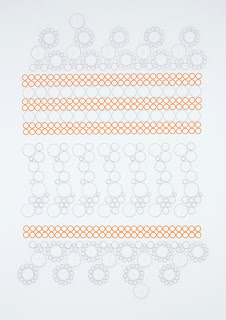
An Interview with artist R. Justin Stewart
1. Can you describe the process through which your work is developed? For example, how did the "Systems of Knowing" exhibition come to fruition?
Systems of Knowing grew out of my previous work which was an investigation into an empirical system, the Minneapolis / St. Paul Transit System. This current work is an investigation into how information can be translated into different conceptual frameworks using various building and construction techniques. Working with a system of building rather than of data, allowed me more flexibility to experiment with the forms and materials.
2. How did the 2008 Esquire commission happen, and what impact has that had on your self-perception, your work and your career?
The Esquire commission came about because my piece 2am-2pm received a lot of interest on a number of mapping and info-graphics blogs. The Art Director at Esquire was searching for an artist to do a sculptural / 3-D data-visualization and he came across my work on one of these blogs and emailed me, which started the conversation. It is difficult to draw direct connections between this experience and future opportunities, but it was really exciting to share my work with a broader audience through a non-arts magazine.
3. Visually, a lot of your recent work seems to signify constellations of relationship. To what extent does your work reflect a perspective on social interaction?
Much of my work has dealt with issues of relationships, either directly or tangentially, over the past few years. I am interested in the continually changing dynamics of identity through the interplay of relationships. An obvious example of a system that is perpetually changing is a social network. I approach my work from the same perspective, that the various elements of a piece physically pull on each other and impact how the other is viewed and created."System of Knowing #4" 17.5 x 40 x 26 inches
4. How does one go from being a self-proclaimed jock to a notable emerging artist within a few short years? What have been the defining moments along the way, and how does that prior training show up in your creative process today?
In actuality, it was a long, slow process of forgetting everything I knew and opening my mind to vagueness and ambiguity, which I was not comfortable with at a younger, more sports-oriented age. It is difficult to identify any particular milestones, but I think the concept of intense practice, continually laboring toward an end goal, is very prevalent in sports and has impacted my approach to art-making. Just as many athletes don't always enjoy the practices, but do it in order to have success in the game, I don't always enjoy the making process, but know that the end result will be well worth it. Nevertheless, I still wish I could replace my large amount of sports knowledge with art knowledge!
5. Talk a bit about color and material, and how they are resolved within a given installation.
I tend to use a lot of color, but in a very controlled manner. Most of the time, the rules I set up for a piece determine the colors, rather than creative intuition. The materials I utilize come from a practical concern, I begin with an idea or thought in my mind and I have to seek out materials that will create that idea while dealing with issues of gravity and such. It often takes many trips to the hardware store and lots of experimentation.
6. To what extent is a site-specific installation a direct response to the space itself?
A site-specific installation definitely must be built for its location. My work is more site-influenced, where the installations tend to be tailored to the space, but the bulk of the installation is predetermined and could be installed anywhere with minor alterations.
7. Generally speaking, what inspires you?
I draw most of my inspiration from reading non-fiction books. Some of the most influential are Guns, Germs, and Steal (Diamond), Bowling Alone (Putnam), Seeing is Forgetting (Westchler), Zero: The biography of a dangerious idea (Seife), Age of Unthinkable (Ramo). Each of these books, and many others, have opened my mind to new ideas and challenged my thinking.
8. What's it like being a New York artist now, compared to your experience as a Minneapolis artist? Does that transition inform your work?
My work, in some ways, has gotten smaller, due to the limited space available in NY. But generally speaking, both cities offer a talented, diverse and interesting community both for the arts and in general. Also, the quality of galleries, museums and alternative spaces are incredible in both cities.
9. You're the first out-of-state artist to engage in a fairly long-term residency at Redline, here in Denver. Do you have specific objectives that you would like to accomplish during your tenancy there?
The most important part of this residency is the opportunity to work alongside the other talented Red Line artists. My specific objectives for this time were to complete the Systems of Knowing work, begin experimenting on new work and read some new books. In addition I hope to spend this time getting to know the Denver arts community.
10. You've been working quite a bit in the third and fourth dimensions. What's next?
At this point, I haven't determined where my new work is going. I like to keep an open mind and see where this experience takes me.







